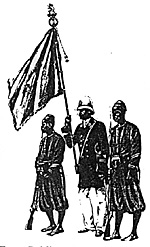 The new Heliograph arrived today and I read
your remarks about not having any information on
the dress of the Belgians. I am enclosing some
photocopies of the series of postcards ."Historie de
la Force Publique du Congo", done by the Musee
Royal Du Congo-Belge in Tervuren, with color
descriptions for the soldiers and officers.
The new Heliograph arrived today and I read
your remarks about not having any information on
the dress of the Belgians. I am enclosing some
photocopies of the series of postcards ."Historie de
la Force Publique du Congo", done by the Musee
Royal Du Congo-Belge in Tervuren, with color
descriptions for the soldiers and officers.
Also (on the cover), a photocopy of an illustration appearing in L'Armee Belge depicting the various uniforms of the Force Publique of 1896. My notes give the author as Rouen, and I believe it covered the period 1871 to 1915. Anyway, Part IV covers the Force Publique. The caption under the drawing reads: FORCE PUBLIQUE OF THE CONGO FREE STATE STATE INSPECTOR ; SOLDIERS AND OFFICERS OF THE FORCE PUBLIQUE, 1896.
The uniform worn by the soldiers is described on page 678:
- The soldiers uniform consists, for full
dress, of a blouse of navy blue serge set off
with a red stripe at the neck and wrists, and
of puffed trousers of the same stuff down to
the knees and held up by means of a wide red
flannel sash. As headgear, the red Egyptian
Fez. The Black soldiers did not like to confine
their feet in shoes, however some of the
Zanzibaris, for example, wore sandals. For
undress, the uniform, instead of being serge, is
of cloth.
Armament included an Albini rifle, a bayonet or yataghan and a waistbelt of tan leather with cartridge box.
On page 679 the text also gives the following for the Auxiliary Company of the Railroad.
- The dress of the auxiliary company of
the railroad is that of the State troops, except
that the blouse and cap bore the letters "C.F."
as a distinctive mark.
C.F. stands for chemin defer, or railroad.
A color plate in the same source shows a native soldier in the dress described, sash etc., with a cartridge box of tan leather. Of course the watercolors on the museum cards depict a black cartridge box. It should also be added that the soldiers do not appear to have worn the waist sash in the field. The plate in L'Armee Belge also shows an officer in the background, attired in a collarless white jacket and white tropical helmet.
On a different matter, reading is beginning to show that one could put together a unit of each of the Darkest Africa range and have a high old time fighting large battles that are based on historical fact. Mirambo had an army of RugaRuga. On occasion he needed to enlarge his force, and sometimes it included bands of Masai warriors. At first the Ngoni (Zulus could be substituted) were allies as well, but later they fought against him. For opposition, an Arab force might include an explorer with 50 armed askaris. Odd contingents of native warriors were supplied to either side by various chiefdoms as well as depending on who they were allied with.
One last item. I passed by a table of used books the other day and saw a book entitled Safari by Bartle Bull. It was a large sized paperback published by Penguin. The original edition was published by Viking in 1988. It appeared to be a history of the African big game safari. I noticed some interesting photos and illustrations having to do with the Victorian period. Not sure how much of the text was actually taken up with this, but it might be useful for a white hunter scenario, etc.
Also
Back to The Heliograph #115 Table of Contents
Back to The Heliograph List of Issues
Back to Master Magazine List
© Copyright 1999 by Richard Brooks.
This article appears in MagWeb (Magazine Web) on the Internet World Wide Web.
Other military history articles and gaming articles are available at http://www.magweb.com